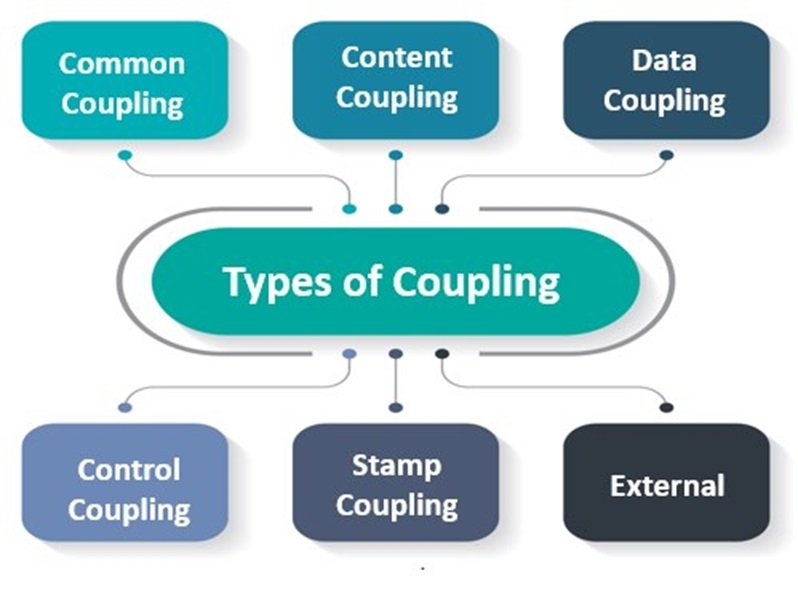Table of Contents
Introduction – Types of Coupling
Hey there, fellow tech enthusiasts! Today, we’re going to talk about an essential concept in software engineering: coupling. If you’ve been in the software development game for a while, you’ve likely heard this term tossed around. But what exactly does it mean, and why should you care? Let’s dive into the different types of coupling in software engineering, with real-life examples to make it all crystal clear.
What is Coupling?
In the simplest terms, coupling refers to the degree of direct knowledge that one module has of another. In other words, it’s about how closely connected different pieces of your software are. Lower coupling is generally preferred because it makes your code more modular, easier to maintain, and less prone to errors.
Now, let’s break down the different types of coupling, from the most undesirable to the most desirable.
Types of Coupling
1. Content Coupling (Pathological Coupling)
Content coupling occurs when one module directly modifies the content of another. This is the highest degree of coupling and is highly discouraged because it leads to fragile and difficult-to-maintain systems.
Real-Life Example:
Imagine you have a function A that directly changes the internal data of function B. If B is modified, A might break without any warning. It’s like having a house of cards – change one card, and the whole structure might collapse.
2. Common Coupling
Common coupling happens when multiple modules share the same global data. This type of coupling is also quite high and problematic because changes to the global data can affect all the modules that access it.
Real-Life Example:
Consider a software application where several modules rely on a global configuration object. If one module changes the configuration, it can have unintended side effects on other modules. It’s like having several cooks in the kitchen using the same pot of salt – one adds a pinch, another adds a tablespoon, and suddenly the soup is inedible.
3. External Coupling
External coupling occurs when two modules share an externally imposed data format, communication protocol, or interface. This is necessary for interacting with external systems but should be managed carefully.
Real-Life Example:
Think about integrating with a third-party API. Your module must adhere to the API’s communication protocol. If the API changes, your module must also change to accommodate it. It’s like speaking a language – if the language rules change, you need to adapt your communication.
4. Control Coupling
Control coupling happens when one module controls the behavior of another by passing control information (e.g., flags or control parameters). This can lead to a dependency on the specific control structure.
Real-Life Example:
Imagine a function A that calls function B with a flag that tells B what to do. If B changes how it interprets the flag, A might need to be updated. It’s like giving instructions based on conditional statements – if the conditions change, the instructions might no longer be valid.
5. Stamp (Data-Structured) Coupling
Stamp coupling occurs when modules share a composite data structure and only use parts of it. This type of coupling can be reduced by passing only the necessary data.
Real-Life Example:
Consider a function that passes an entire customer object to another function, even though the receiving function only needs the customer’s ID and name. It’s like sending an entire filing cabinet when you only need one document – it’s inefficient and can lead to unnecessary dependencies.
6. Data Coupling
Data coupling is when modules share data by passing only the necessary data items. This is a lower level of coupling and is generally desirable.
Real-Life Example:
If function A calls function B and passes only the necessary parameters, like a customer ID, it’s straightforward and efficient. It’s like sharing just the needed information – clear, concise, and effective.
7. Message Coupling (Loose Coupling)
Message coupling occurs when modules communicate using messaging systems, such as events or messages, without needing to know about each other’s internal structures. This is the loosest form of coupling and is highly desirable.
Real-Life Example:
Think about a microservices architecture where services communicate through message queues or HTTP requests. Each service operates independently and only interacts through well-defined messages. It’s like having a conversation through texts – each person can function independently but still communicates effectively.
Why Coupling Matters
Understanding the Types of Coupling is crucial for building robust, maintainable software. Lower coupling (like data and message coupling) makes your code more modular and easier to test, debug, and extend. Higher coupling (like content and common coupling) can lead to fragile systems that are hard to maintain and prone to bugs.
Real-Life Example: Refactoring for Lower Coupling
Suppose you have an e-commerce application with tightly coupled modules for inventory, payment, and shipping. Changes in one module often break others. By refactoring to use message coupling, each module can operate independently and communicate through well-defined messages. This makes the system more robust and easier to maintain.
Conclusion – Types of Coupling
Coupling is a fundamental concept in software engineering that can significantly impact the maintainability and robustness of your code. By understanding the different types of coupling and striving for lower coupling, you can build more modular, efficient, and resilient software systems.
Next time you’re working on a project, take a moment to consider the coupling between your modules. Aim for lower coupling wherever possible, and your future self – and your team – will thank you!
If you enjoyed this article, please share it with your fellow developers and subscribe for more insights into software engineering. Have any questions or experiences with coupling in your projects? Drop them in the comments below!
Happy coding!




Leave a Reply